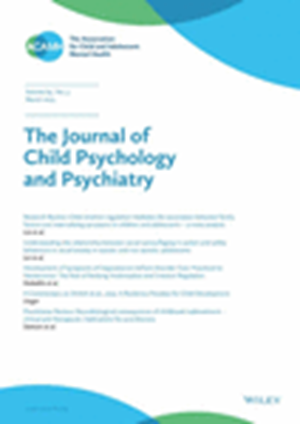Intergenerational transmission of maternal childhood maltreatment, prenatal substance exposure, and internalizing and externalizing symptoms in early adolescence at age 12.
IF 7
1区 医学
Q1 PSYCHIATRY
引用次数: 0
Abstract
BACKGROUND Few studies have examined the intergenerational impact of maternal childhood maltreatment (MCM) in the context of prenatal substance exposure (PSE). This study investigates whether PSE is part of the pathway of MCM or an independent risk factor affecting offspring psychopathology. METHODS Participants were 284 birth mother-child (44% male) dyads, primarily Black, low-income, enrolled at birth. Exposure to alcohol, tobacco, marijuana, or cocaine in utero was assessed at 1 month postpartum. MCM was assessed at child age 4, and maternal psychological distress and offspring maltreatment at child age 10. Mother- and child-reported internalizing and externalizing symptoms were assessed at child age 12 using the Child Behavior Checklist and the Youth Self-Report. Structural equation modeling was conducted to test sequential mediation pathways examining the direct and indirect associations of MCM with child internalizing and externalizing symptoms via PSE, maternal psychological distress, and offspring maltreatment, adjusting for covariates. RESULTS MCM was directly related to adolescent-reported internalizing and externalizing symptoms, whereas PSE was directly related to adolescent-reported externalizing symptoms. MCM and PSE were indirectly related to mother-reported internalizing and externalizing symptoms via maternal psychological distress. Only PSE was related to offspring maltreatment at 10 years, and offspring maltreatment was related to both mother- and adolescent-reported internalizing and externalizing symptoms at 12 years. CONCLUSIONS MCM and PSE may increase offspring vulnerability to psychopathology, highlighting the importance of evaluating historical risks that mothers may transmit from their own childhood maltreatment and prenatal substance use in assessing offspring psychopathology.母亲童年虐待的代际传递,产前物质暴露,以及12岁青少年早期的内化和外化症状。
在产前物质暴露(PSE)的背景下,很少有研究调查了母亲童年虐待(MCM)的代际影响。本研究探讨PSE究竟是MCM通路的一部分,还是影响子代精神病理的独立危险因素。方法研究对象为284对出生的母子(44%为男性),主要为黑人,低收入,出生时登记。产后1个月评估子宫内暴露于酒精、烟草、大麻或可卡因的情况。在儿童4岁时评估MCM,在儿童10岁时评估母亲心理困扰和子女虐待。在儿童12岁时,使用儿童行为检查表和青少年自我报告对母亲和儿童报告的内化和外化症状进行评估。采用结构方程模型检验序列中介途径,通过PSE、母亲心理困扰和后代虐待来检验MCM与儿童内化和外化症状的直接和间接关联,并对协变量进行调整。结果smcm与青少年内在化和外在化症状直接相关,PSE与青少年外在化症状直接相关。MCM和PSE通过母亲心理困扰间接与母亲报告的内化和外化症状相关。只有PSE与10岁时的后代虐待有关,而后代虐待与母亲和青少年在12岁时报告的内化和外化症状有关。结论smcm和PSE可能增加子代精神病理易感性,强调评估母亲童年虐待和产前物质使用对子代精神病理的遗传风险对评估子代精神病理具有重要意义。
本文章由计算机程序翻译,如有差异,请以英文原文为准。
求助全文
约1分钟内获得全文
求助全文
来源期刊
CiteScore
13.80
自引率
5.30%
发文量
169
审稿时长
1 months
期刊介绍:
The Journal of Child Psychology and Psychiatry (JCPP) is a highly regarded international publication that focuses on the fields of child and adolescent psychology and psychiatry. It is recognized for publishing top-tier, clinically relevant research across various disciplines related to these areas. JCPP has a broad global readership and covers a diverse range of topics, including:
Epidemiology: Studies on the prevalence and distribution of mental health issues in children and adolescents.
Diagnosis: Research on the identification and classification of childhood disorders.
Treatments: Psychotherapeutic and psychopharmacological interventions for child and adolescent mental health.
Behavior and Cognition: Studies on the behavioral and cognitive aspects of childhood disorders.
Neuroscience and Neurobiology: Research on the neural and biological underpinnings of child mental health.
Genetics: Genetic factors contributing to the development of childhood disorders.
JCPP serves as a platform for integrating empirical research, clinical studies, and high-quality reviews from diverse perspectives, theoretical viewpoints, and disciplines. This interdisciplinary approach is a key feature of the journal, as it fosters a comprehensive understanding of child and adolescent mental health.
The Journal of Child Psychology and Psychiatry is published 12 times a year and is affiliated with the Association for Child and Adolescent Mental Health (ACAMH), which supports the journal's mission to advance knowledge and practice in the field of child and adolescent mental health.

 求助内容:
求助内容: 应助结果提醒方式:
应助结果提醒方式:


